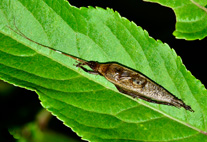Abstract
The Southeast region off Chile and Peru has yielded a very rich diverse fauna of basal chitons of the genus Leptochiton. The present contribution is based on the study of 1055 specimens of chitons. Thirteen leptochitonid species are reported of which seven species are new, namely Leptochiton lascrusesi n. sp., L. linseae n. sp., L. longibranchiae n. sp., L. peruvianus n. sp., L. macleani n. sp., L. sigwartae n. sp., and L. mutschkeae n. sp. Five species were found on the shelf, but only one of those is limited to this zone. The other eight species live in bathyal or abyssal depths. Thus, 12 of 13 species were found deeper than 200 m. The genus Leptochiton originated in the late Palaeozoic in shallow waters. It probably shifted to deep-waters because of competition by more advanced genera of chitons. The leptochitonid fauna of the Peru-Chile Trench turned out to be rich. Five species were studied from this trench system. Two of them—L. longibranchiae n. sp. and L. peruvianus n. sp.—are characterized by an unusually high number of gills and an accordingly wider distribution in the mantle cavity, reaching in an anterior direction to valves V and III. This morphological peculiarity is unusual for Lepidopleurida and resembles the conditions found in the order Chitonida.

